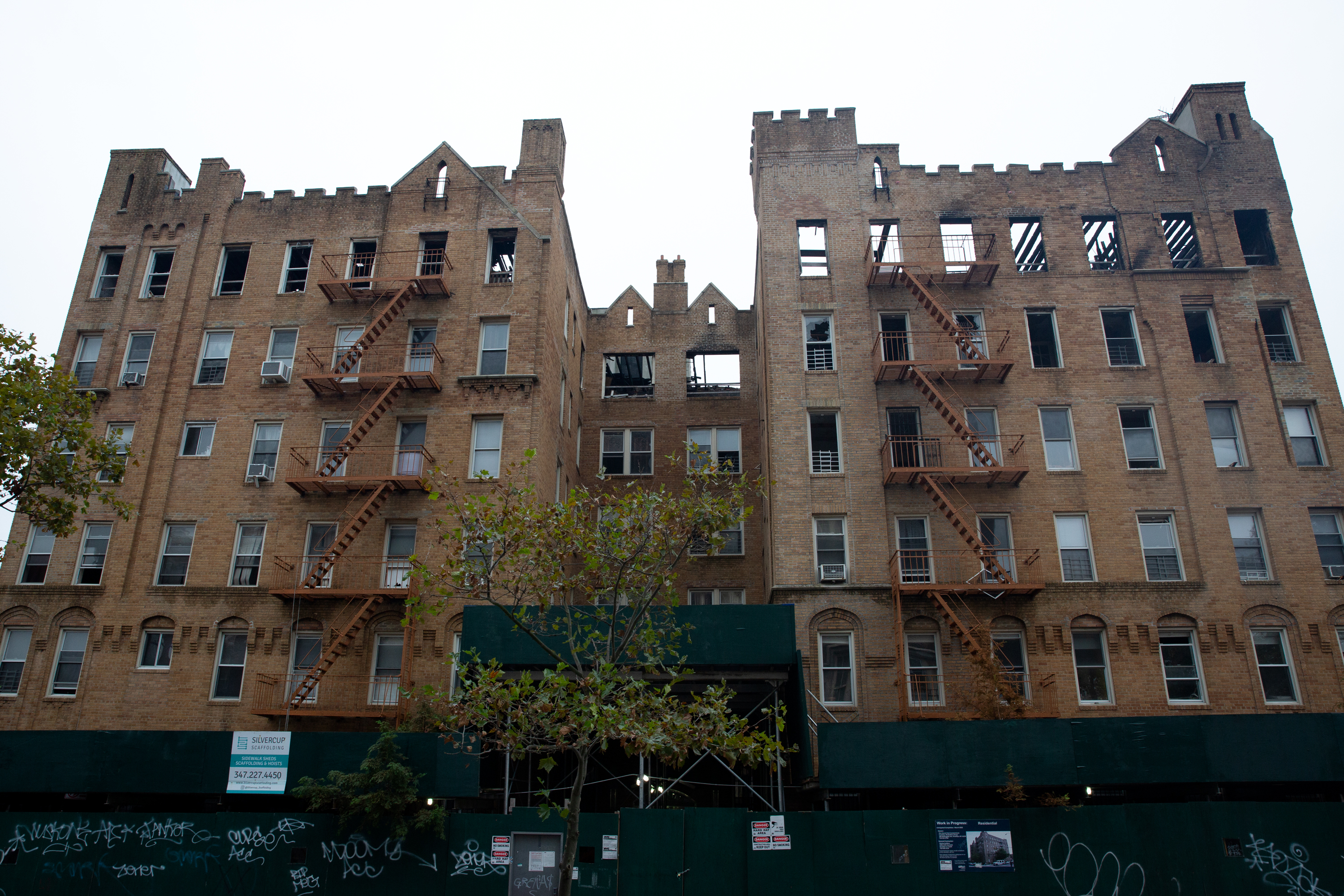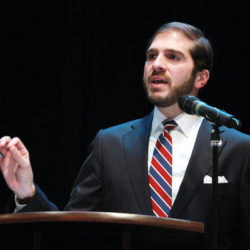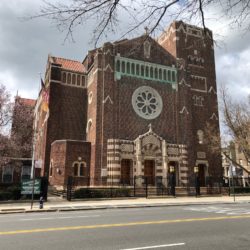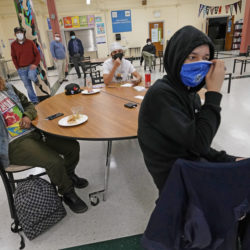Their Brooklyn building burned last year. Who’s responsible for making it whole again?
David Marrero struggled to find a home for his ailing mother after they were forced out of their Sunset Park home when their building was destroyed in a fire. Photo: Ben Fractenberg/THE CITY
 This story was originally published on Nov. 16 by THE CITY. Sign up here to get the latest stories from THE CITY delivered to you each morning.
This story was originally published on Nov. 16 by THE CITY. Sign up here to get the latest stories from THE CITY delivered to you each morning.
David Marrero wasn’t home on the afternoon of April 3, 2019, when a fire broke out in the sixth-floor apartment next to the one he was raised in.
His elderly mother was, however — and barely escaped with the help of a neighbor.
By the time he got to the scene, “the entire sixth floor” — the building’s top floor — “was blown up.”
The inferno that tore through the apartment building on the corner of Seventh Avenue and 44th Street in Sunset Park, rendering its 54 units uninhabitable, was sparked by an unattended candle lit in Apartment 6-B, according to the Fire Department.
The six-alarm fire raged, aided by 30- to 40-mile-per-hour winds, for more than a day. When the smoke cleared, city inspectors quickly declared all of the building off-limits.
The residents, many of them families who’d lived in the building for decades, became homeless overnight. The fire also killed 13 cats and one dog. And it reduced priceless photos, mementos and other personal belongings to ash.
All Marrero’s personal documents and family photos, including baby pictures of him and shots of his mother as a young woman, were gone.
–>
“It’s hard to see your entire life go up in smoke,” he said plaintively.
More than a year and a half after the fire, Marrero and many of his former neighbors are still struggling to rebuild their lives.
He’s among 10 tenants who have filed suit against the building’s management company demanding repairs that would allow them all to move back in.
Under New York’s rent stabilization laws, if the derelict building gets reconstructed, its 17 renter households would have a right to reoccupy their former apartments.
Owning debts
But displaced tenants aren’t the only former residents seeking a say.
Three dozen of the apartments were condominiums with individual owners, who have different ideas. In January, about three-fourths of them voted to sell the derelict property — an outcome that could lock out the former rent-stabilized tenants forever.
The owners of 37 condos are themselves in court, asking a judge to allow them to pool together their interests in order to sell the property as a whole.

Like the tenants, the owners have been piecing their lives back together in exile. Unlike the tenants, they still owe mortgage and property tax payments month after month, while also paying for new living quarters.
They say they’re too broke to reconstruct their building, which their engineer estimates would cost $25 million, according to court documents.
Among the condo residents is local Community Board 7 Chair César Zúñiga, who lived on the fourth floor with his partner and their two sons.
Zúñiga was at his nonprofit job on Long Island when he learned the building was ablaze. His sons, then ages 9 and 6, were in the apartment with their babysitter.
He was driving westward on the Belt Parkway 10 miles away, “breaking several traffic laws,” when he saw the smoke.
“Oh my God,” he remembered thinking. “Is this really happening?”
His sons made it out of the building unharmed, as did their babysitter. The family’s cats, Scratch and Neo, did not survive.
“I remember I just stood in front of the building with the Fire Department, and I was speechless, like I was in suspended animation looking at what was happening,” Zúñiga said.
“I kept saying to myself, ‘OK, it’s all good, the kids are out, nothing else matters.’”
Zúñiga’s family tried and failed to find a rental they could afford in the neighborhood, and temporarily crashed with his partner’s parents in nearby Park Slope while they looked, eventually settling in Bay Ridge.
“We really want to go back to the neighborhood,” said Zúñiga, who is running for the City Council seat to be vacated by term-limited Councilmember Carlos Menchaca (D-Brooklyn). “It’s our home.”
‘Everybody’s a loser’
In January, Zúñiga’s household was among the majority of condominium owners who voted not to make repairs in the building and to instead sell the property.
The building’s 37 condominium owners all hold individual common interests for their own units, as well as individual insurance plans — an arrangement common in condominium conversions of apartments, according to their attorney, Theresa Racht.
The 17 rentals are under the ownership of landlord Paul Klasner, whose attorneys did not respond to THE CITY’s request for comment.
The condo owners contend the building is beyond repair, and they cannot afford to make even emergency repairs, according to Racht. She also argued that the condo owners have no responsibility to the tenants — that only Klasner, who owns the rental units, does.
‘I’m never going to be able to live in as nice a place again.’
Emily Mann, Zúñiga’s partner and a member of the condominium board, stressed that the decision to sell was not easy.
“Believe me, I’m very empathetic to the tenants and the situation that they’re in, but I’m never going to be able to live in as nice a place again, either,” Mann, a social worker, said.
Unlike owners in a cooperative building, who would be able to apply for a loan to make repairs jointly as a single corporation, the condo owners would each have to apply for individual loans to make repairs, Racht said.
“They’ve lost everything. They lost their photographs and homes and now they’re still paying their mortgage and real estate taxes,” she said. “They have not lost those obligations because there was a fire.
“No one is getting any kind of win here at all — everybody’s a loser. There’s enough pain to go around for everyone.”
Mann noted that in order to repair the building, each of the owners would have “to come up with a quarter of a million dollars, and no one has that money.”
“This is not a situation where the owners are winning at the tenants’ expense,” she added. “I mean, I lost my kids’ baby blankets, every photo of their lifetime, as well as all the equity. We’re all still paying mortgages and people are losing tremendously. People will have to declare bankruptcy.”
“It’s brutally bad for everyone.”
Tenants’ bid
A decision in favor of the tenants could stop the owners from selling and force them to spend whatever is necessary to temporarily reconstruct the derelict structure. The building is missing half of its roof, with the top three floors partially hollowed out.
Sixteen apartments, including Marrero’s, were rent-stabilized, and one was rent-controlled, all occupied by longtime tenants.
Marrero and tenants in nine other rent-stabilized units initially sued the management company, the condominium corporation and the city Department of Housing Preservation and Development in Housing Court in July 2019, demanding the building be restored and that the owners pay to relocate tenants.
The following month, the city Department of Housing Preservation and Development filed its own case to press for repairs.
The tenants’ legal team — they are being represented by the nonprofit Legal Services NYC, as well as law firm Arnold & Porter pro bono — refiled their case in Brooklyn Supreme Court in December.
‘If they can’t rebuild, they should make necessary emergency repairs.’
Meanwhile, none of the building’s residents have been let back in since shortly after the fire, when they were briefly allowed to recover whatever belongings they could.
The condominium corporation and the management company, the suit charges, “failed to maintain adequate insurance coverage to address events such as a building-wide fire, and have further failed to take any meaningful action to repair the condition of the building following the fire.”
The apartment building was insured at slightly more $8 million, according to a declaration from its insurer included in court papers.
The condominium corporation and the landlord have “refused” to let the tenants and their legal team conduct an independent inspection of the property, despite having their own engineer available pro bono, said Logan Schiff, a Legal Services attorney representing the tenants.
If the building is demolished or destroyed, he said, the tenants would lose their rights to their rent-stabilized units. But if the building is rehabilitated — whether by the owners and Klasner or a new owner — the tenants would be able to return, he noted.
“We know they don’t have funds to rebuild, but the fact that they don’t have the means doesn’t absolve them of their responsibility or allow them to let this building sit dilapidated for years,” he said.
“If they can’t rebuild, they should make necessary emergency repairs,” such as a temporary roof, he said, “so they can sell as fast as legally possible to someone who is in the position to fully repair and maintain it in the interim.”
Priced out
It took some tenants weeks and others months to find housing after the fire, according to Schiff. The last tenant to be housed, he said, was in April — a year after the fire.
He noted that many of the rent-stabilized tenants are elderly and did not have renters’ insurance.
Displaced tenants found themselves suddenly priced out of the neighborhood, said Assemblymember-elect Marcela Mitaynes (D-Brooklyn), who has assisted the tenants as an organizer with Neighbors Helping Neighbors, a local advocacy group.
“Suddenly, a lot of families found themselves paying twice as much for an apartment half the size of the one they lived in, on top of the financial burden brought on by the fire,” Mitaynes said.
That includes Marrero, who only found a place to rent on his own in the neighborhood earlier this year, after crashing with family. His mother, Julia, died in May at age 74.
After spending $1,475 a month on his spacious one-bedroom apartment, he was aghast at the cost of rentals in the gentrifying neighborhood — as much as $2,100 a month for a similar unit, he said.
“I’m in a bracket where I’m a boss,” said Marrero, 41, a supervisor with the Parks Department. “And yet, I can’t afford the neighborhood I grew up in.”
The other tenants, like Marrero, are determined to move back into the building.
Ivette Dávila-Richards grew up in the building and raised her daughter there. They moved to an apartment in the neighborhood but are eager to return.

“I’m not gonna lie, it does get emotional some days where I’m like, ‘I can’t find these bags or this sweater, or this book,’” she said. “And then it hits all over again.”
Another tenant, Marcela Salazar, 65, said there are times she feels “desperate.”
Like Dávila-Richards, the retiree eventually found an apartment elsewhere in the neighborhood. She spent six months in a hotel after the fire until securing Section 8 housing.
“People just want to go back home,” said Salazar, who lost her cat and dog, a Shih-Tzu named Princess — “the love of my life” — in the blaze.

She passes by her old home on her way to Sunset Park walking her new dog, Juju, every day.
“I always cry when I look up at the building.”
THE CITY is an independent, nonprofit news outlet dedicated to hard-hitting reporting that serves the people of New York.




